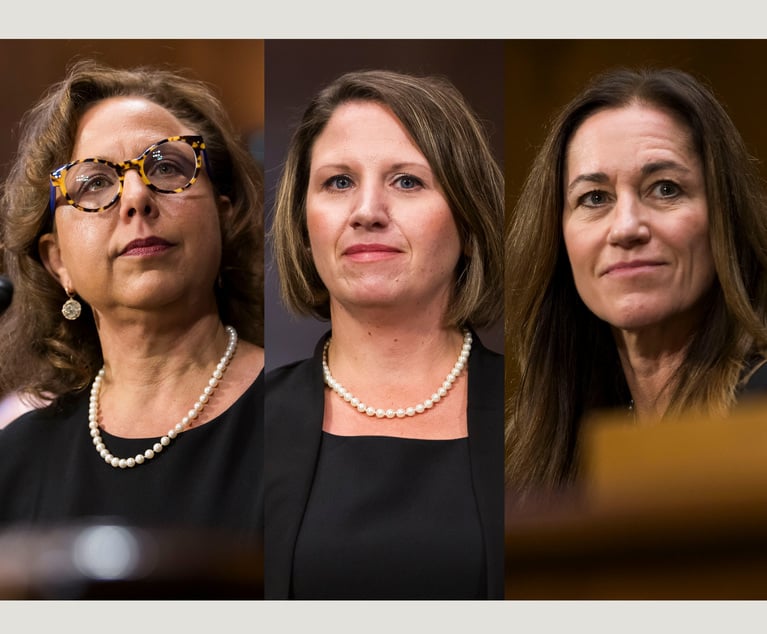Allocating Between Covered and Uncovered Damages—What Is an Insurer To Do?
Who pays? In most civil cases, that is the ultimate question. But, in many cases involving an insured defendant, a jury's verdict does not fully answer the question. Often, the insurer defends under a reservation of rights because the plaintiff seeks both covered and uncovered damages.
July 30, 2020 at 01:58 PM
10 minute read
 Anthony L. Miscioscia, left, and Timothy A. Carroll, right, of White and Williams.
Anthony L. Miscioscia, left, and Timothy A. Carroll, right, of White and Williams.Who pays? In most civil cases, that is the ultimate question. But, in many cases involving an insured defendant, a jury's verdict does not fully answer the question. Often, the insurer defends under a reservation of rights because the plaintiff seeks both covered and uncovered damages. The presence of both covered and uncovered damages creates a need to allocate any judgment between covered and uncovered amounts or claims—either at trial or thereafter—to determine what amounts are the responsibility of the defendant, and what amounts the defendant's insurer must indemnify.
This need to allocate, in turn, raises questions of who has the burden of allocation—the insurer or the insured—and when, and in what forum, allocation should be decided.
Case law on this issue is sparse. But, earlier this year, in a span of two months, three different courts addressed the issue. In doing so, they identified reasons why intervention may be needed, highlighted the practical and ethical problems presented by insurers intervening in a case against their own insureds, and offered guidance on how insurers can navigate these waters.
The concept of intervention obviously is not new. In Pennsylvania, the leading cases on an insurer's need to intervene are now over 25 years old. In Stidham v. Millvale Sportsmen's Club, 421 Pa. Super. 548 (1992), the estate of a bar patron whom the insured had shot and killed brought a wrongful death action against the insured. The insured pleaded guilty to third degree murder and aggravated assault. The insurer then denied coverage based on an expected or intended exclusion. It did not seek to intervene. The case went to trial, resulting in a verdict against the insured. In the garnishment proceeding commenced by the estate to recover the verdict from the insurer, the Superior Court held that the insurer was estopped from litigating the insured's intent for purposes of determining the applicability of the exclusion. The insurer could have litigated the issue in the underlying action, the court reasoned, but it failed to do so.
A few years later, in Butterfield v. Giuntoli, 448 Pa. Super. 1 (1995), the Superior Court held that once an insured proved the existence of a judgment and policy that covered it, the burden shifted to the insurer to prove what portion was excluded. The court further suggested that an insurer defending under a reservation of rights should intervene and request special jury interrogatories, or risk being precluded from contesting coverage for a general verdict.
In Butterfield, the jury awarded punitive damages against the insured, but did not specify whether they were based on direct or vicarious liability. Pennsylvania law prohibits coverage for punitive damages based on direct liability. The insurer argued there was no coverage because the insured could not establish that the damages were based on vicarious liability. The trial court agreed.
On appeal, the Superior Court reversed, concluding that the insurer, whose representative attended the trial, did not act to have the "direct versus vicarious liability" issue resolved, but should have done so. The Court admonished the insurer for not intervening or taking other action to request that the trial court address the issue. The insurer, thus, was held liable for the full award.
Since Stidham and Butterfield, Pennsylvania courts generally have disfavored an insurer's attempt to intervene. Judges will not allow insurance issues to be interjected into their cases. Plaintiffs do not want to alter the presentation of their case to account for insurance concerns. And, insureds do not want any verdict form or interrogatories that would have multiple places for a jury to award damages, or would clearly identify noncovered awards.
But, then, how do an insured and insurer effectuate their rights under the insurance policy, in a way that requires the insurer to indemnify the insured only for covered amounts? Three recent cases suggest two ways that this necessary allocation can be addressed—shifting the burden of proof by attempting intervention, or a post-judgement declaratory judgment action.
Rockhill Insurance v. CFI-Global Fisheries Management, 2020 U.S. Dist. LEXIS 35209 (D. Colo. March 2, 2020), reinforces the dangers should an insurer not attempt to intervene. There, the insurer and insured disputed coverage for a general arbitration award. The insurer defended the insured under a reservation of rights, filed a separate declaratory judgment action, and argued that the award could be allocated between covered and uncovered amounts. Emphasizing that the insurer controlled the defense, the court concluded that it "had a corresponding duty to ensure that the damages were allocated between those that were covered under [the] policy and those that were not." Because the insurer failed to request an allocated award, the arbitrators issued a standard award without explaining their reasoning. Under those circumstances, the court held that the damages were presumed to be covered.
QBE Specialty Insurance v. Scrap, 2020 U.S. App. LEXIS 8015 (11th Cir. March 13, 2020) suggests intervention in the underlying action is not required. In Scrap, the plaintiff sued the insured for nuisance, alleging that the operation of its metal shredding facility created loud noises, offensive odors and fumes, and vibrations to neighboring homes. QBE agreed to defend the insured under a reservation of rights. Numerous times during the case, QBE advised the insured of its need for special jury interrogatories and verdict forms. And, QBE twice moved to intervene for the limited purpose of requesting such interrogatories and verdict forms, but the trial court denied intervention. The insured was later found liable and QBE sued to deny coverage. Highlighting QBE's prior efforts to allocate including repeated, but unsuccessful, attempts to intervene, the U.S. Court of Appeals for the Eleventh Circuit held that an insurer need not successfully intervene. Rather, it need only advise the insured of the need for an allocation and take steps (even if unsuccessful) to bring about that result. "The standard is notice, not successful intervention," the court explained, and "that standard was certainly met here." QBE "had a duty to inform Scrap of the availability and advisability of a special verdict, lest the burden shift; QBE did so; the burden thus did not shift, but remained on Scrap, which is unable to meet it." So, QBE ultimately won by placing the burden of allocation on the insured, even after failing to intervene in the underlying action.
In the last and most recent of the cases, Builders Mutual Insurance v. Island Pointe, 2020 S.C. LEXIS 68 (S.C. May 13, 2020), the Supreme Court of South Carolina offered a different solution to the allocation problem — a post-judgment declaratory judgment action addressing allocation. There, the insured faced a $17.5 million construction defect claim involving a property owners' association, construction contractors, and subcontractors (the insureds). The insurers provided independent defense counsel to the insureds pursuant to a reservation of rights to later contest whether any damages awarded were covered. About three years later, just before discovery closed, the insurers moved to intervene "for the limited purpose of participating in the preparation of a special verdict form or a general verdict form accompanied by answers to interrogatories for submission to the jury during trial." The trial court denied the motions to intervene, and the insurers appealed.
On appeal, the Supreme Court upheld the lower court's denial of intervention, holding that the insurers were not entitled to intervene as a matter of right because they did not show that they had a direct interest in the underlying litigation. The court also ruled that the trial court did not abuse its discretion in denying permissive intervention, because the record supported the court's finding that the insurers' intervention would unnecessarily complicate the action, possibly delay the trial, and create a conflict of interest for the insureds' counsel. The court explained that, absent the insurers' intervention, the plaintiff association had no need to parse its damages into categories corresponding to the coverage provided in a CGL policy, over-burdening the plaintiff. As to the conflict of interest, the court explained that permitting a verdict form with special interrogatories would place the insureds' counsel in the untenable position of conceding liability so as to focus instead on damages. Defense counsel argued that a special verdict would force them to alter their presentation of evidence to describe as much of the association's damages as possible as consequential water intrusion (which they believed to be covered) as opposed to faulty workmanship (which would not be). To do so, counsel feared they would have to concede that the insured's work was faulty.
Mindful of these concerns, the South Carolina Supreme Court suggested an alternative to intervention: the insurer may contest coverage in a post-judgment declaratory judgment action, in recognition that insurers have a right to a determination of what part of a damages award is covered under a policy. In such an action, neither the insureds nor the insurers are precluded from introducing evidence about which damages are covered (or excluded from coverage) by the policy, the court explained. But, the court added, the parties cannot contest the total amount of any jury verdict, and are to use the transcript of the merits hearing as the primary source of evidence in the declaratory judgment action. However, additional evidence that is relevant to determining coverage can be presented, such as expert testimony.
These three recent decisions demonstrate the importance of an insurer doing what it can to seek allocation between covered and uncovered damages before the underlying action concludes. Insurers defending under a reservation of rights should advise their insureds of the need and ability to allocate through special jury interrogatories or verdict forms. Should an insured refuse, insurers should consider intervening to do so themselves, assuming the facts presented to the fact-finder allow for allocation and that the costs of allocation make financial sense when compared to the potentially uncovered damages. If intervention is denied (as it often is), insurers then should argue that the insured bears the allocation burden (as in QBE) or, alternatively, that they should be permitted to litigate allocation in a subsequent declaratory judgment action (as proposed in Builders). While the recent cases still leave many questions unanswered (such as what to do with the underlying plaintiff now holding a judgment), they also highlight that insurers which do nothing risk liability for the whole damages award. It's not a question of successful intervention, but rather, whether an attempt has been made.
Anthony L. Miscioscia is a partner at White and Williams. He is co-chair of the insurance coverage and bad faith group and bad faith extra-contractual liability group.
Timothy A. Carroll is an associate at the firm.
This content has been archived. It is available through our partners, LexisNexis® and Bloomberg Law.
To view this content, please continue to their sites.
Not a Lexis Subscriber?
Subscribe Now
Not a Bloomberg Law Subscriber?
Subscribe Now
NOT FOR REPRINT
© 2025 ALM Global, LLC, All Rights Reserved. Request academic re-use from www.copyright.com. All other uses, submit a request to [email protected]. For more information visit Asset & Logo Licensing.
You Might Like
View All
Pa. Federal District Courts Reach Full Complement Following Latest Confirmation

The Defense Bar Is Feeling the Strain: Busy Med Mal Trial Schedules Might Be Phila.'s 'New Normal'
7 minute read
Federal Judge Allows Elderly Woman's Consumer Protection Suit to Proceed Against Citizens Bank
5 minute read
Judge Leaves Statute of Limitations Question in Injury Crash Suit for a Jury
4 minute readLaw Firms Mentioned
Trending Stories
- 1SDNY Criminal Division Deputy Chief Returns to Debevoise
- 2Brownstein Adds Former Interior Secretary, Offering 'Strategic Counsel' During New Trump Term
- 3Tragedy on I-95: Florida Lawsuit Against Horizon Freight System Could Set New Precedent in Crash Cases
- 4Weil, Loading Up on More Regulatory Talent, Adds SEC Asset Management Co-Chief
- 5Big Banks Did Great Last Year. What Does That Mean for Big Law?
Who Got The Work
J. Brugh Lower of Gibbons has entered an appearance for industrial equipment supplier Devco Corporation in a pending trademark infringement lawsuit. The suit, accusing the defendant of selling knock-off Graco products, was filed Dec. 18 in New Jersey District Court by Rivkin Radler on behalf of Graco Inc. and Graco Minnesota. The case, assigned to U.S. District Judge Zahid N. Quraishi, is 3:24-cv-11294, Graco Inc. et al v. Devco Corporation.
Who Got The Work
Rebecca Maller-Stein and Kent A. Yalowitz of Arnold & Porter Kaye Scholer have entered their appearances for Hanaco Venture Capital and its executives, Lior Prosor and David Frankel, in a pending securities lawsuit. The action, filed on Dec. 24 in New York Southern District Court by Zell, Aron & Co. on behalf of Goldeneye Advisors, accuses the defendants of negligently and fraudulently managing the plaintiff's $1 million investment. The case, assigned to U.S. District Judge Vernon S. Broderick, is 1:24-cv-09918, Goldeneye Advisors, LLC v. Hanaco Venture Capital, Ltd. et al.
Who Got The Work
Attorneys from A&O Shearman has stepped in as defense counsel for Toronto-Dominion Bank and other defendants in a pending securities class action. The suit, filed Dec. 11 in New York Southern District Court by Bleichmar Fonti & Auld, accuses the defendants of concealing the bank's 'pervasive' deficiencies in regards to its compliance with the Bank Secrecy Act and the quality of its anti-money laundering controls. The case, assigned to U.S. District Judge Arun Subramanian, is 1:24-cv-09445, Gonzalez v. The Toronto-Dominion Bank et al.
Who Got The Work
Crown Castle International, a Pennsylvania company providing shared communications infrastructure, has turned to Luke D. Wolf of Gordon Rees Scully Mansukhani to fend off a pending breach-of-contract lawsuit. The court action, filed Nov. 25 in Michigan Eastern District Court by Hooper Hathaway PC on behalf of The Town Residences LLC, accuses Crown Castle of failing to transfer approximately $30,000 in utility payments from T-Mobile in breach of a roof-top lease and assignment agreement. The case, assigned to U.S. District Judge Susan K. Declercq, is 2:24-cv-13131, The Town Residences LLC v. T-Mobile US, Inc. et al.
Who Got The Work
Wilfred P. Coronato and Daniel M. Schwartz of McCarter & English have stepped in as defense counsel to Electrolux Home Products Inc. in a pending product liability lawsuit. The court action, filed Nov. 26 in New York Eastern District Court by Poulos Lopiccolo PC and Nagel Rice LLP on behalf of David Stern, alleges that the defendant's refrigerators’ drawers and shelving repeatedly break and fall apart within months after purchase. The case, assigned to U.S. District Judge Joan M. Azrack, is 2:24-cv-08204, Stern v. Electrolux Home Products, Inc.
Featured Firms
Law Offices of Gary Martin Hays & Associates, P.C.
(470) 294-1674
Law Offices of Mark E. Salomone
(857) 444-6468
Smith & Hassler
(713) 739-1250





